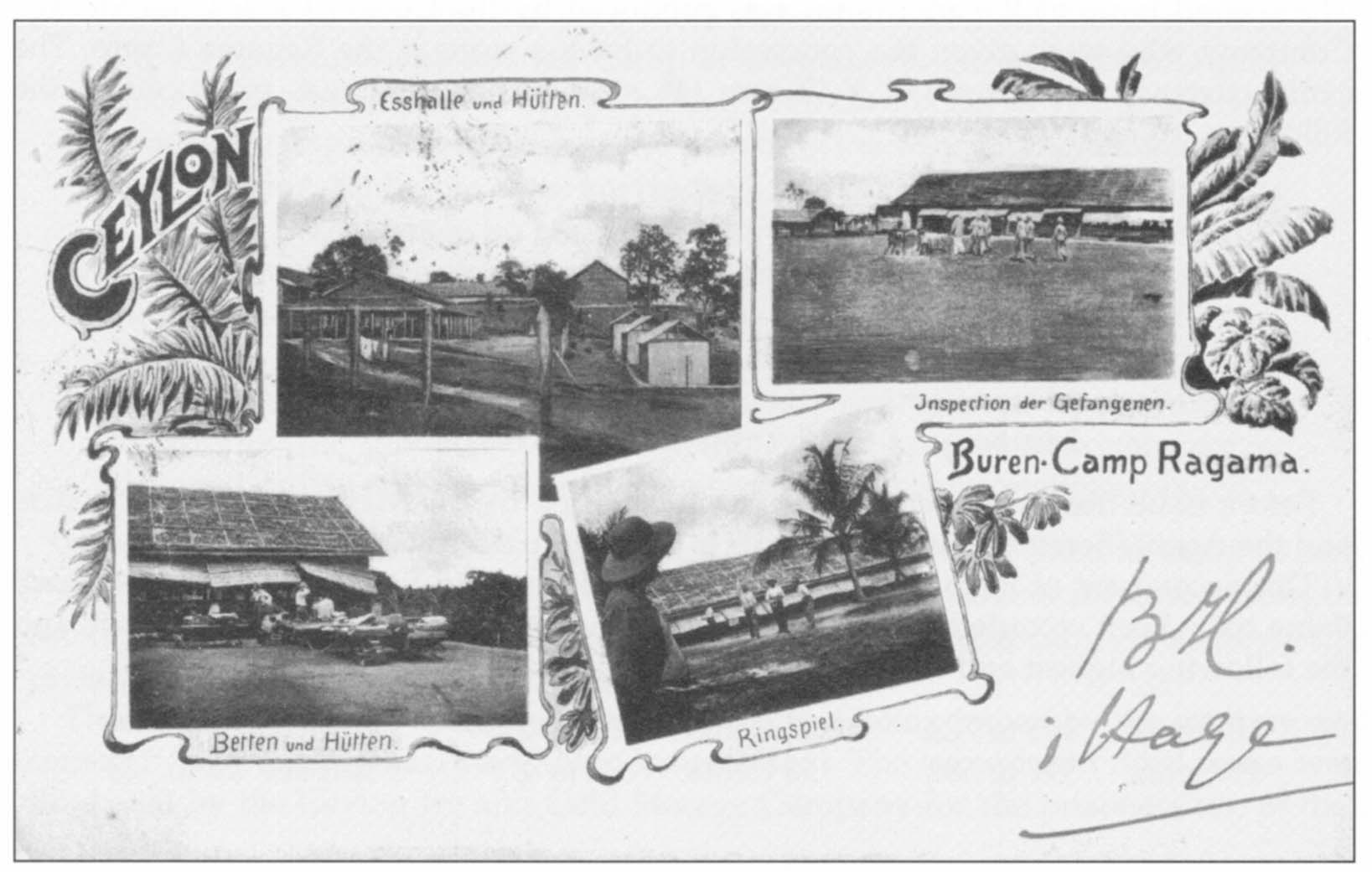

The prisoner of war camp at Ragama was opened on 8 January 1901 and was situated 16 km north of Colombo. Some of the Boer prisoners had been giving the Diyatalawa camp staff considerable trouble and therefore it was decided to remove them to a separate camp at Ragama.
A. W. Andree's booklet Illustrations of Life in the Boer Camp which was published in April 1901 gives an early impression of the conditions of the first few months in the following extract:
After some months' residence in Ceylon it was deemed politic to make a division of prisoners, and a supplementary camp was constructed in the vicinity of the Immigrant Cooly Segregation Camp, which is situated about ten miles on the main line between Colombo and Kandy. At Ragama are interned 300 of the captives, comprising what is known as 'The foreign element'. The Camp is situated on an elevation partially sheltered by a coconut plantation, and as regards climatic conditions contrasts favourably with residence on the Colombo seaside. The number of prisoners includes seventeen officers, who are provided with separate quarters. The arrangements for the prisoners' comfort are everything that can be desired. There is a plentiful supply of wholesome water which is pumped by machinery into the camp. The guard is supplied by officers and men of the Gloucester Regiment, and Mr. A. C. Elliott, of the Ceylon Civil Service, acts as Censor and General Assistant to the Commandant. The precautions adopted to prevent prisoners escaping are on a more elaborate scale than those in use at the more distant and isolated Camp at Diyatalawa. No instance of a prisoner having attempted to escape having been chronicled as yet. In fact, it is practically impossible for any one to penetrate the wire entanglements with out detection, for before these are reached, a sloping covering of thin netting six feet in height has to be broken and concealed; under this are wires, contact with which sets electric alarm bells in the guard room in motion. This simple and ingenious device, known as the MacNamara Patent Electric Alarm, is the work of Mr. P. T. MacNamara, Assistant Superintendent of Telegraphs, whose services were subsequently requisitioned by the Imperial authorities for the Boer Camps in India. The huts of prisoners are of thatched cadjan and are roomy, well ventilated and comfortably arranged.
Although this account gives a good idea of the situation at the Ragama camp in early 1901, it was not many months before the numbers of prisoners increased from the 300 that was originally planned. From postal items sent from the camp, it is known that prisoners were still at Ragama during September 1902.
Three sets of Ragama notes were printed, the first being issued by the military, and signed by Capt. I. Ingram, the Camp Commandant. The second and third series were produced by the Ceylon Ice and Cold Storage Company for the prisoners use at their own store.
The notes, which were printed locally, measure 4½ x 3¼ inches (114 x 83 mm). The notes were printed in the following colours:
| Value | Colours |
| 10 Cents | Black and red on light brown |
| 25 Cents | Black and purple on brown |
| 50 Cents | Black and purple on pale brown |
| 1 Rupee | Black and purple on pale gold |
| 5 Rupees | Black and red on grey/green |
From the few notes recorded, it would appear numbering commenced with No. 1. To date the following highest and lowest are recorded.
| 10 Cents | 57 to 486 |
| 25 Cents | 94 to 298 |
| 50 Cents | 81 to 484 |
| 1 Rupee | 226 to 513 |
| 5 Rupees | 32 to 162 |
| Value | Colours |
| 10 Cents | Black and red on yellow |
| 15 Cents | Black and red on peach |
| 25 Cents | Black and red on orange |
| 50 Cents | Black on red |
| 1 Rupee | Black and red on blue |
| 5 Rupees | Black and red on pink |
| 10 Cents | 405 to 723 |
| 15 Cents | 397 to 582 |
| 25 Cents | 325 to 436 |
| 50 Cents | 76 to 479 |
| 1 Rupee | 5 to 199 |
| 5 Rupees | 13 to 43 |
| Value | Colours |
| 5 Cents | Black on beige |
| 10 Cents | Black on yellow |
| 25 Cents | Black on orange |
| 50 Cents | Black on red |
| 1 Rupee | Black on green |
| 5 Rupees | Black on lilac |
| 5 Cents | 7 to 249 |
| 10 Cents | 7 to 241 |
| 25 Cents | 4 to 257 |
| 50 Cents | 3 to 484 |
| 1 Rupee | 7 to 437 |
| 5 Rupees | 7 to 119 |






|
Excerpt pages 76-81 taken from Paper Currency of the Anglo-Boer War 1899-1902 by John Ineson, published in 1999, reproduced by kind permission of Spink and Son Ltd. Text and images were scanned, OCRed and edited. | 
|